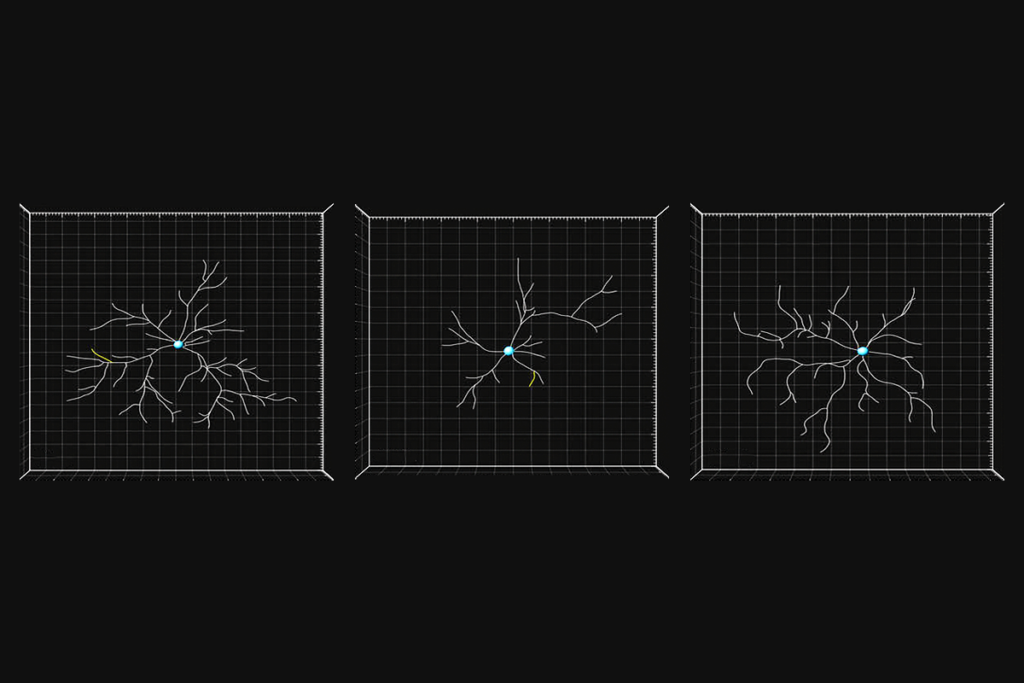
Noisy patterns of connectivity mark autism brains
A new study may have solved a decade-old debate about whether the brains of people with autism are more or less connected than those of controls: They’re both, depending on where in the brain you look.
A new study may have solved a decade-old debate about whether the brains of people with autism are more or less connected than those of controls: They’re both, depending on where in the brain you look. The study, published 19 January in Nature Neuroscience, suggests that a mix of abnormally strong and weak brain connections is a hallmark of the disorder1.
“In the very same individual, we can see both, depending on spatial distribution,” says Marlene Behrmann, professor of psychology at Carnegie Mellon University in Pittsburgh.
Behrmann and her colleagues analyzed functional magnetic resonance imaging (fMRI) scans from 68 adults with high-functioning autism and 73 age-matched controls. As a group, people with autism showed the opposite pattern of connectivity to that seen in controls.
“Those areas that are typically highly connected were less connected in [the autism group], and those areas that are typically less connected were more connected in the autism group,” says Behrmann.
On an individual level, however, the researchers found noisier patterns of connectivity in the brains of people with autism than in controls. The more these patterns deviate from those of controls, the more severe a person’s autism symptoms tend to be.
The findings jibe with previous studies from Behrmann’s team, which suggest that signaling in the brains of people with autism is more variable than in controls. They may also help to reconcile discrepant findings on brain connectivity that have dogged autism researchers for years.
“They’re actually saying that maybe everyone with [autism] is just different from that canonical response or pattern of brain activity,” says Dan Kennedy, assistant professor of psychological and brain sciences at Indiana University in Bloomington, who was not involved in the work.
The findings also fit with the growing appreciation of autism’s heterogeneity. “We know there are lots of different causes of autism and different developmental trajectories,” says Kennedy. “To expect that everyone with autism is going to show some clear biological commonality might be incorrect.”
Parsing patterns:
Most previous studies of brain connectivity in autism had smaller sample sizes and focused on a select few regions of the brain. In the new study, Behrmann and her colleagues analyzed data from the Autism Brain Imaging Data Exchange (ABIDE), an open-access repository of more than 1,000 fMRI scans from 17 labs worldwide.
They measured connectivity by mapping the level of synchrony between different brain areas across and within the two hemispheres of the brain. Two areas are considered connected when they light up on the scans simultaneously.
Overall, connections that are strong in controls are weaker in people with autism and vice versa. But these group-level differences do not hold up when the researchers look at individual connectivity patterns, which vary widely within the autism group. This idiosyncrasy tracks with autism severity, so that individuals whose brain connectivity is most different from that of controls score highest on the Autism Diagnostic Observation Schedule, a widely used scale for assessing autism.
Some experts say this should come as no surprise. “We do know that regardless of the psychiatric disorder studied, there’s always more variability in patient groups,” says Vinod Menon, professor of psychiatry and behavioral sciences at Stanford University in California, who was not involved in the work.
Others say the findings highlight a new way of thinking about altered brain connectivity in autism. “If it’s confirmed, it brings up a very new avenue of research,” says Adriana Di Martino, assistant professor of child and adolescent psychiatry at New York University’s Langone Medical Center. Di Martino was not involved with the study but manages the ABIDE database.
Di Martino and her colleagues also found evidence for both over- and underconnectivity in the brains of people with autism in a 2013 analysis of 763 scans from ABIDE. But their work differed in that it focused on specific brain circuits and contained a more diverse pool of participants, including children.
Expanding the new study to include children will clarify whether noisy connectivity is a cause or effect of autism, according to Menon. “Mapping out the developmental trajectory of these changes is, I think, going to be an interesting and important action for the future,” he says.
Behrmann says she plans to study children and hopes other labs will extend the study to people with severe autism.
“The more the field can work together to aggregate big datasets,” she says, “it’s my opinion that we will be able to uncover patterns that have heretofore been elusive.”
References:
1. Hahamy A. et al. Nat. Neurosci. 18, 302-309 (2015) PubMed
Recommended reading

Probing the link between preterm birth and autism; and more
Cell ‘antennae’ link autism, congenital heart disease

Neurophysiologic distinction between autism and schizophrenia; and more
Explore more from The Transmitter
Grace Hwang and Joe Monaco discuss the future of NeuroAI

Anti-seizure medications in pregnancy; TBR1 gene; microglia
